/Vehicles/Axis/Germany/06-Panzerartillerie/Others/File/Other-SPG.htm | Last Up-date: 06-08-2021
Other Self-Propelled Howitzers
105 mm leFH18(Sf) & 150 mm sFH13(Sf) auf GW LrS(f)
Deux versions armées d'obusiers furent également produite en nombres limités, le 10.5 cm leFH 18(Sf) auf Gw Lorraine Schlepper(f) et le 150 mm sFH 13/1(Sf) auf Gw Lorraine Schlepper(f) (Sd.Kfz.135/1). En mai 1942, Hitler ordonna que 40 châssis du LrS soient convertis pour pour porter le sFH de 15 cm. Cette conversion était destinée à l'Afrique du Nord. En juillet 78 châssis environ étaient disponibles et Keitel en réserva 30 pour être équipé du 15 cm sFH alors que le reste devaient servir pour le Panzerjäger Marder I. L'affût de cette pièce très lourde surchargea quelque peu le châssis mais l'engin était généralement très apprécié et efficace. En mai 1942, 60 10.5 cm leFH18/4 furent commandés mais seulement 12 furent fabriqués. Ces engins furent versés dans le Panzerartillerie Abteilung de la 21e Pz-Division en Afrique du Nord. Après le retrait allemand d'Afrique, ils étaient encore 54 en service au début de 1944 sur front ouest.
Two versions armed with howitzers were also produced of limited numbers, 10.5 cm leFH 18(Sf) auf Gw Lorraine Schlepper(f) and the 150 mm sFH 13/1(Sf) auf Gw Lorraine Schlepper(f) (Sd.Kfz.135/1) . In May 1942, Hitler ordered that 40 chassis of LrS are converted for carrying the sFH of 15 cm. This conversion was intended for North Africa. In July 78 chassis approximately were available and Keitel held 30 of them to be equipped with 15 cm sFH whereas the remainder were to be useful for Panzerjäger Marder I. The mounting of this weapon was very heavy and overloaded the chassis somewhat but the machine generally was very appreciated and effective. In May 1942, 60 10.5 cm leFH18/4 were ordered but only 12 were manufactured. These machines were versed in Panzerartillerie Abteilung of the 21st Pz-Division in North Africa. After the German withdrawal of Africa, they were still 54 in service at the beginning of 1944 on western front.
/Photo-01.jpg) |
10.5cm leFH18(Sf) auf GW LrS(f)
|
src:
Site WWII
Vehicles |
150
mm sFH 13/1 L/29.6 Penetration of a shielding plate (mm) under a plunging angle of 30° |
|||||||
Ammo |
Weight |
Velocity |
100
m |
500 m |
1000
m |
1500 m |
2000
m |
| Gr 39 H1/A | 25 kg |
465 m/s |
160 |
178 |
167 |
157 |
148 |
/Photo-03.TI9.jpg) |
/Photo-02.narita.jpg) |
15cm sFH13/1(Sf) auf GW LrS(f)
|
|
src: Tank Illustrated n°9
|
|
105
mm sFH 18 L/28 Penetration of a shielding plate (mm) under a plunging angle of 30° |
|||||||
Ammo |
Weight |
Velocity |
100
m |
500 m |
1000
m |
1500 m |
2000
m |
| PzGr | 14 kg |
470 m/s |
63 |
59 |
54 |
50 |
46 |
| Gr 39 H1/A | 12.3 kg |
495 m/s |
80 |
59 |
54 |
50 |
- |
| Gr 39 H1/B | 12.1 kg |
495 m/s |
90 |
59 |
54 |
50 |
- |
| Gr 39 H1/C | 12.35 kg |
495 m/s |
100 |
59 |
54 |
50 |
- |
Data |
Drawings |
122 mm s.FH 396(r) auf GW LrS(f)
L'opération Barbarossa permettra aux Allemands de capturer une masse considérable de matériel à l'armée rouge, dont des obusiers de 122 mm M30 Modèle 1938 en grand nombre, capables d'expédier des projectiles de 22 kg à 12000 m. Facile d'emploi et puissante, cette pièce d'artillerie fut immédiatement adoptée par l'armée allemande et opposée à ses anciens propriétaires, sous le nom de 12.2cm s.FH 396(r). Il en avait tellement, que les Allemands, n'hésitèrent pas à produire des munitions de 122 mm, un calibre pourtant pas en usage chez eux avant cela. Le 10.5 cm leFH 18(Sf) auf Geschützwagen Lorraine Schlepper(f) (basé sur la chenillette française Lorraine 37L), sera modifié pour accueillir l'obusier russe. Il y a peu d'informations sur cet automoteur, référencé comme 12.2 cm sFH 396(r) auf Geschützwagen Lorraine Schlepper(f). Un exemplaire aurait été assemblé et utilisé au combat durant l'été 1944 en France, installé sur un train blindé.
Operation Barbarossa will allow the Germans to capture a considerable mass of material from the Red Army, including 122 mm M30 Model 1938 howitzers in large numbers, capable of shooting 22 kg projectiles at 12,000 m. Easy to use and powerful, this artillery piece was immediately adopted by the German army and opposed to its former owners, under the name of 12.2cm s.FH 396 (r). There were so many of them that the Germans did not hesitate to produce 122 mm ammunition, a caliber not in use by them before that. The 10.5 cm leFH 18 (Sf) auf Geschützwagen Lorraine Schlepper (f) (based on the French tracker Lorraine 37L), will be modified to accommodate the Russian howitzer. There is little information about this self-propelled howitzer, referenced as 12.2 cm sFH 396 (r) auf Geschützwagen Lorraine Schlepper (f). A single vehicle would have been assembled and used in combat during the summer of 1944 in France, installed on an armored train.
/122mm-sFH396r-LrS.jpg) |
12.2cm sFH 396(r) auf GW LrS(f)
|
Drawings |
105 mm leFH18(Sf) auf GW 39H(f)
Le châssis du 39H fut également utiliser pour fournir un affût mobile à l'obusier de 105 mm, le 10.5 cm leFH 18(Sf) auf Gw 39H(f).
The chassis of the 39H was also to use to provide a mobile mounting to the howitzer of 105 mm, 10.5 cm leFH 18(Sf) auf Gw 39H(f).
/Photo-02.jpg) |
/Photo-03.jpg) |
/Photo-01.ch.jpg) |
10.5cm leFH18(Sf) auf GW 39H(f) |
||
src: Site WWII
Vehicles
|
src: Connaissance de l'Histoire (Hachette) -
N°5 - " Véhicules blindés allemands 39-45"
|
|
Data |
Drawings |
105 mm leFH16/18(Sf) auf GW FCM(f)
Le char moyen français FCM 36 fut utilisé comme affût mobile pour obusier, le 10.5 cm leFH 16/18(Sf) auf gw FCM(f) et produit en petits nombres.
The french medium tank FCM 36 was used like mobile mounting for howitzer, 10.5 cm leFH 16/18(Sf) auf gw FCM(f) and produced in small numbers.
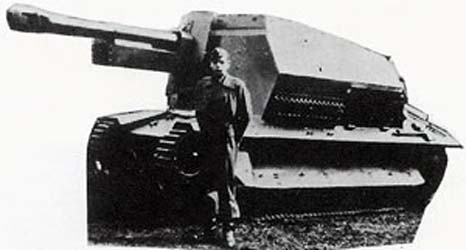 |
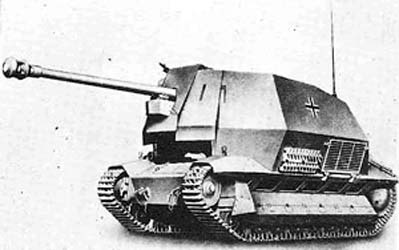 |
10.5cm leFH16(Sf) auf GW FCM(f) |
|
src: Site WWII
Vehicles
|
|
Data |
Drawings |
105 mm leFH16 (Sf) auf GW Mk.VI(e)
Le char léger Mk.VI britannique fut utilisé comme affût mobile pour obusier, le 10.5 cm leFH 16/18(Sf) auf gw Mk.VI(e) et produit en petits nombres (6 à 12).
The British light tank Mk.VI was used like mobile mounting for howitzer, 10.5 cm leFH 16/18(Sf) auf gw Mk.VI(e) and produced in small numbers (6 to 12).
/pic-1.jpg) |
/pic-2.jpg) |
10.5cm leFH16(Sf) auf GW Mk.VI(e) |
|
src: Site reddit
|
src:
Site Google
sites |
Drawings |
| Data | |
| Dimensions | |
| Weight: 8200 kg - Crew: 4 - Length: 5.38 m - Width: 2 m - Height: 2.26 m | |
| Propulsion | |
| Engine: Meadows 6-cylinder, 88 hp - Fuel: petrol | |
| Performances | |
| Speed: 56 km/h (on road), 40 km/h (off road) - Range: 210 km (on road) - ? km (off road) | |
| Armament | |
| Type: 105 mm le.FH.16(Sf) & 1 x 7.92 mm MG 34 - Ammo: - |
|
| Armor | |
| 4-14 mm | |
105 mm leFH18(Sf) auf GW B2(f)
L'obusier léger (leH 18) de 105 mm fut également montés sur le char lourd français B1bis capturé. L'arme était montée dans une superstructure avant sur la caisse du char français dont on avait retiré le canon de 75 mm monté en casemate. Cet engin fut indiqué 10.5 cm leFH 18(Sf) auf Gw B1bis(f).
The light howitzer (leH 18) of 105 mm was also assembled on the French captured B1bis heavy tank. The weapon was assembled in a front superstructure on the hull of the French tank which one had withdrawn the gun of 75 mm assembled in casemate. This machine was indicated 10.5 cm leFH 18(Sf) auf Gw B1bis(f).
/Photo-01.ch.jpg) |
10.5cm leFH18(Sf) auf GW B1-bis(f) |
src: Connaissance de l'Histoire (Hachette) -
N°5 - " Véhicules blindés allemands 39-45"
|
10.5 cm LG auf Gepanzerte Munitionsschlepper
En septembre de 1937, on envisagea de développer un transport de munitions blindé entièrement chenillé. Le prototype, le VK302 (Sonderschlepper BIII) fut produit en 1940. Une commande initiale de 20 véhicules fut suivie d'une autre de 100 véhicules mais seulement 28 furent produits, d'octobre 1941 à janvier de 1942 par Borgward.
In September of 1937, one planned to develop an entirely tracked armoured transport of ammunition. The prototype, the VK302 (Sonderschlepper BIII) was produced in 1940. An initial ordering of 20 vehicles was followed of another of 100 vehicles but only 28 were produced, from October 1941 to January of 1942 by Borgward.
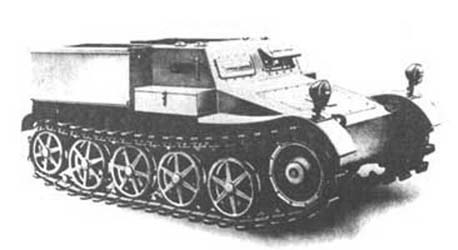 |
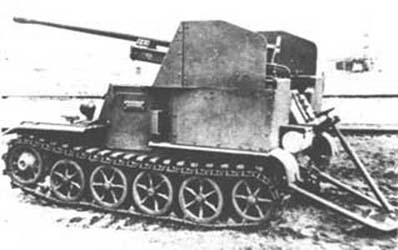 |
Gepanzerte Munitionsschlepper
(VK302)
|
Panzer Selbstfahrlafette
1a 5 cm PaK38 auf Gepanzerte Munitionsschlepper |
src: Site "Achtung
Panzer" |
src: Site "Achtung
Panzer" |
En septembre de 1941, fut monté sur le Gepanzerte Munitionsschlepper un canon de 105 mm sans recul développé par Rheinmetall-Borsig. Le canon était monté dans une tourelle développée par Krupp montée au dessus du compartiment moteur. Seules des maquettes furent produites.
In July of 1940, a leichte panzerjäger was realized on the basis of Gepanzerte Muntionsschlepper. It was armed with the gun of 50 mm Pak 38 assembled to the top of the engine compartment. In 1940, a prototype was built and was examined on the ground but never started production.
| Data | |
| Dimensions | |
| Weight: 3500 kg (VK302) - Crew: 2 - Length: 3.57 m - Width: 1.83 m - Height: 1.44 m | |
| Propulsion | |
| Engine: Borgward 6M RTBV, 6 cyl., 49 hp - Fuel: Gasoline | |
| Performances | |
| Speed: 30 km/h (on road), ? km/h (off road) - Range: 150 km (on road) - ? km (off road) | |
| Armament | |
| Type: 105 mm LG L/32 - Ammo: ? |
|
| Armor | |
| 8-14.5 mm | |
8cm s.Gr.W 34 auf Panzerspähwagen Renault ZT AMR 35 702(f)
En raison du manque de véhicule d'appui armé d'un mortier comme le semi-chenillé Sd.Kfz.251/2 mittlere Schützenpanzerwagen mit 8 cm schwere Granatwerfer 34 (8cm s.Gr.W 34), l'arméé allemande décida de convertir les AMR-35 français capturés (Panzerspähwagen Renault ZT AMR 37 702(f)). La tourelle fut remplacée par une casemate ouverte sur le dessus de 10 mm d'épaisseur. Le véhicule fut nommé 8cm s.Gr.W 34 auf Panzerspähwagen Renault ZT AMR 35 702(f) ou Mörserträger AMR(f). Le mortier était dirigé vers l'avant et le pointage en azimut se faisait en jouant sur les chenilles. Le mortier d'un calibre réel de 81.4 mm expédiait un projectile de 3.5 kg à 2400 m de distance. Le véhicule disposait en plus d'une radio FuG.Spr.a1. Le véhicule aurait été servi par un équipage de 4 hommes. Des exemplaires retrouvés dans un cimetière de matériel allemands, prouve sa présence en Normandie, durant l'été 1944.
Due to the lack of a support vehicle armed with a mortar such as the semi-tracked Sd.Kfz.251/2 mittlere Schützenpanzerwagen mit 8 cm schwere Granatwerfer 34 (8cm s.Gr.W 34), the German army decided to convert captured French AMR-35s (Panzerspähwagen Renault ZT AMR 37 702 (f)). The turret was replaced by an open top casemate (10 mm thick). The vehicle was named 8cm s.Gr.W 34 auf Panzerspähwagen Renault ZT AMR 35 702 (f) or Mörserträger AMR (f). The mortar was directed forward and the azimuth pointing was done by playing on the tracks. The mortar with a real caliber of 81.4 mm sent a 3.5 kg projectile, 2400 m away. The vehicle also had a FuG.Spr.a1 radio. The vehicle would have been served by a crew of 4 men. Vehicles found in a German material cemetery, proves its presence in Normandy, during the summer of 1944.
 |
8cm s.Gr.W 34 auf Panzerspähwagen
Renault ZT AMR 35 702(f)
|
Drawings |
Avec le nouveau châssis du Panzer 38(d), version germanisée du Panzer 38(t) d'origine tchèque, les Allemands disposent d'une base plus grande et mieux motorisée pour développer une vaste gamme de véhicules militaires. Parmi les développements possibles, celui d'un porte-mortier, équipé du monstrueux mortier lourd de 280 mm. On peut se poser des questions par rapport à ce type d'engin, les obusiers auomoteurs présentent plus de souplesse d'emploi notamment grâce à leur chargement par la culasse, par rapport à un mortier, arme chargée par la gueule. Cependant le mortier est capable de tirer sous un angle de plus de 45°, assurant à un projectile à forte charge explosive, une trajectoire de chute proche de la verticale, ... très utile en terrain accidenté, contre des positions retranchées, en milieu urbain ...
With the new chassis of the Panzer 38 (d), Germanized version of the Panzer 38 (t) of Czech origin, the Germans have a larger and better motorized base to develop a wide range of military vehicles. Among the possible developments, that of a mortar carrier, equipped with the monstrous 280 mm heavy mortar. One can ask questions about this type of machine, the self-propelled howitzers have more flexibility of use in particular thanks to their loading by the breech, compared to a mortar, weapon loaded by the muzzle. However, the mortar is capable of firing at an angle of more than 45°, ensuring a projectile with a high explosive charge, a fall trajectory close to the vertical, ... very useful in rough terrain (with relief), against entrenched positions, in the urban environment...
C'est une configuration dite "Motor Mitte" (moteur installé au centre) qui est choisie pour le 28cm Sturmmörser 38(d). Cette configuration libère un espace à l'arrière du véhicule pour accueillir le volumineux mortier lourd de 28cm, avec son tube lisse de 4.005 m par ailleurs assez difficile d'être installé l'espace mesuré d'un véhicule blindé léger. En plus de la difficulté d'installation d'un tel mortier, un autre problème majeur apparaît. En effet le châssis est trop léger pour encaisser la force de recul du tir, qui risque fort d'endommager les composants mécaniques. L'engin dispose d'une plaque de base pour compenser mais de ce fait (et en raison du chargement par la gueule), le mortier ne peut être utilisé en mouvement mais seulement en position d'arrêt, mis en batterie comme une pièce d'artillerie classique. Si comme pour les autres mortiers plus petits, le chargement se fait par gueule, en raison de la longueur du tube il y a cependant de notables différences. En effet est impossible d'introduire le projectile quand le tube est en position de tir comme sur un mortier d'infanterie, cela ne se peut que si le tube est en position horizontale via une grue (le projectile pesant en effet 228 kg !). Cette contrainte à un impact évident sur la cadence de tir, le tube devant être abaissé et relevé après et avant chaque tir. De plus dans un mortier standard, c'est le contact du projectile lâché avec le fond du tube (grâce à une amorce) qui déclenche le tir, ce qui est impossible ici, dès lors le mortier lourd dispose d'une culasse avec un mécanisme de mise à feu. Le mortier peut faire feu avec une élévation allant de +38° à +80° et un débattement latéral de 40°. L'espace intérieur du véhicule offre peu d'espace pour les munitions, la présence d'un transport de munitions est donc indispensable (peut être un Kätzchen modifié avec grue de chargement). Lors des déplacement, le tube était positionné à l'horizontale et poussé en partie dans le véhicule, la plaque de base accrochée à l'arrière (voir chargée sur par le transport de munitions). Pour ne pas trop charger le véhicule, le blindage frontal est réduit à 30 mm. L'épaisseur du tube est amincie pour que celui-ci ne pèse qu'une tonne. L'armement défensif était composée d'une seule mitrailleuse MG-42 sur le toit, actionnée à distance, depuis l'intérieur.
It is a configuration "Motor Mitte" (engine installed in the center) which is chosen for the 28cm Sturmmörser 38 (d). This configuration get a space at the rear of the vehicle to accommodate the voluminous 28cm heavy mortar, with its 4,005 m smooth barrel otherwise quite difficult to install the measured space of a light armored vehicle. In addition to the difficulty of installing such a mortar, another major problem arises. Indeed the chassis is too light to bear the recoil force of the shot, which risks damaging the mechanical components. The vehicle has a base plate to compensate thr recoil, but because of this (and because of the loading by the muzzle), the mortar cannot be used in move but only in the stop position, in battery like a standard artillery piece. If, as for the other smaller mortars, the loading is done by muzzle, due to the length of the barrel there are however notable differences. Indeed, it is impossible to introduce the projectile when the barrel is in firing position as on an infantry mortar, this can only be done if the barrel is in horizontal position via a crane (the projectile indeed weighing 228 kg!) . This constraint has an obvious impact on the rate of fire, the tube having to be lowered and raised after and before each shot. In addition, in a standard mortar, it is the contact of the falling projectile with the bottom of the barrel (thanks to a primer) which triggers the firing, which is impossible here, therefore the heavy mortar has a breech with a mechanism of firing. The mortar can fire with an elevation ranging from + 38 ° to + 80 ° and a lateral traverse of 40 °. The interior space of the vehicle offers little space for ammunition, so the presence of an ammunition carrier is essential (maybe a modified Kätzchen with loading crane). During travel, the barrel was positioned horizontally and partly pushed into the vehicle, the base plate hooked to the rear (see loaded on the ammunition carrier). In order not to overload the vehicle, the frontal armor is reduced to 30 mm. The thickness of the tube is thinned so that it weighs only one ton. The defensive armament consisted of a single MG-42 machine gun on the roof, operated remotely, from the interior.
/p1.jpg) |
Sturmmörser 38(d)
|
La taille du Sturmmörser 38(d) en faisait un véhicule discret capable d'approcher assez près du front. Cette arme portée offrait plus de mobilité qu'une pièce tractée (mise en batterie et retraite (ou progression) sur le champ de bataille, plus faciles en principe). Cependant la puissance du mortier et le processus de chargement imposaient un tir en position d'arrêt. Cette position fixe, d'une durée plus ou moins longue, augmentait le risque de représailles et avec elles les risques de destruction et de capture. On le voit l'engin est peu réactif à une menace directe, ne peut guère se défendre tout seul (son armement principal étant inutile dans ce cas de figure) et doit donc être protégé par de l'infanterie au minimum, voir un accompagnement blindé. De plus lors des chargement de l'arme, le(s) chargeur(s) étai(en)t en dehors du véhicule et donc sans protection. En comparaison, les obusiers automoteurs sont capables si nécessaire de faire feu en mouvement, de prendre à partie les blindés ennemis en tir direct et l'ntiereté de l'équipage reste à l'intérieur en situation de combat. En définitive, la fin de la guerre mettra un terme au projet.
The size of the Sturmmörser 38 (d) made it an inconspicuous vehicle capable of approaching quite close to the front. This carried weapon offered more mobility than a towed artillery piece (putting in battery and retreating (or progression) on the battlefield, easier in principle). However, the power of the mortar and the loading process required firing in a stop position. This fixed position, of varying duration, increased the risk of reprisals and with them the risks of destruction and capture. As we can see, the machine is not very reactive to a direct threat, can hardly defend itself (its main armament being useless in this case) and must therefore be protected by at least infantry, see armored support . In addition, when loading the weapon, the loader(s) was(were) outside the vehicle and therefore unprotected. In comparison, self-propelled howitzers are capable of firing on the move if necessary, or attacking enemy armor in direct fire, and the entire crew remains inside the vehicle in combat. Ultimately, the end of the war will put an end to the project.
Drawings |
Grille 17/21/30 auf Geschützwagen VI Tiger
En 1942, Krupp reçu la commande d'un waffenträger lourd basé sur le châssis du Panzerkampfwagen VI Ausf.B Tiger II (Tigre Royal) afin de porter une série d'armes différentes. Le premier, le Grille 17 devait être armé du canon de 170 mm K 72 L/50. Le poids de ce nouveau canon automoteur ne devait pas dépasser les 53-58 tonnes. On pensa également à un Grillle 21 armé du mortier de 210 mm 18/1 L/31 ainsi qu'à un Grille 30 armé du mortier Skoda de 305 mm GrW L/16. Quant au Grille 42 il devait être équipé du mortier de 420 mm Grw. En 1943-1944, Krupp travailla sur un prototype, avec comme échéance, la mi 1945 pour l'entrée en production, mais la fin de la guerre rompra le développement.
In 1942, Krupp received the ordering of a heavy waffenträger based on the chassis of Panzerkampfwagen VI Ausf.B Tiger II (King Tiger) in order to carry a series of different weapons. The first, Grille 17 was to be armed with the gun of 170 mm K 72 L/50. The weight of this new self-propelled gun was not to exceed the 53-58 tons. One also thought of Grillle 21 armed with the mortar of 210 mm 18/1 L/31 as with a Grille 30 armed with the Skoda mortar of 305 mm GrW L/16. As for Grille 42 it was to be equipped with the mortar of 420 mm Grw. In 1943-1944, Krupp worked on a prototype, with like expiry, the mid 1945 for the entry in production, but the end of the war will break the development.
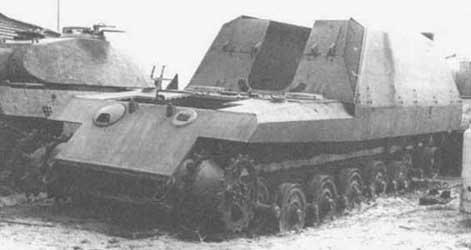 |
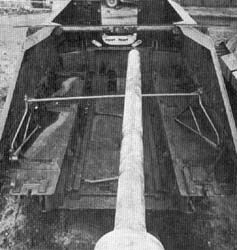 |
Waffenträger "Grille"
17 cm K72, 21 cm MRS 18/1 ünd 30.5cm GRW (Sf)
|
|
src: Site "Achtung
Panzer"
|
src: Site 2ièmeguerre.com |
L'armement principal de ces waffenträgers devait être monté sur une plate-forme sur rail à l'intérieur d'une superstructure arrière, ouverte au dessus et à l'arrière. Pour leur défense rapprochée, chaque modèle disposait de deux mitrailleuses de 7,92 mm (caisse, poste de combat). L'équipage était composé de de huit hommes: le conducteur, le commandant, le tireur, 4 chargeurs et l'opérateur radio. Un moteur 12 cylindres (essence) Maybach HL230P30 ou HL230P45 devait leur permettre de voyager à la vitesse maximum de 45 km/h sur route avec une autonomie de 250 km (1000 litres). Avec le canon, l'engin mesurait 13 mètres de long, 3,27 mètres de large et 3,15 mètres de haut. Sa superstructure était faite de parois inclinées épaisses à l'avant de 30 mm et de 16 mm sur les côtés. L'espace à l'intérieur du compartiment de combat ne permettait sur le Grille 17 (58000 kg) que de transporter 5 projectiles et sur le Grille 21 (52700 kg) seulement 3 projectiles. En mai de 1945 un prototype de Grille 17 sans son armement fut complété mais fut capturé près de Paderborn par les Britanniques.
The principal armament of these waffenträgers was to be asembled on a platform on rail inside a back superstructure, opened on the top and the back. For their local defense, each model had two machine-guns of 7,92 mm (hull, station of combat). The crew was composed of eight men: the driver, the commander, the gunner, 4 loaders and the radio operator. A 12 cylinders (gasoline) Maybach HL230P30 or HL230P45 engine was to enable them to travel at the maximum speed of 45 km/h on road with an range of 250 km (1000 liters). With the gun, the machine was 13 meters long, 3.27 meters broad and 3.15 meters in height. Its superstructure was made with tilted walls thick in front of 30 mm and of 16 mm on the sides. Space inside the compartment of combat did not make it possible to Grille 17 (58000 kg) to transport only 5 projectiles and to the Grille 21 (52700 kg) only 3 projectiles. In May of 1945 a prototype of Grille 17 without its armament was supplemented but captured close to Paderborn by the British.
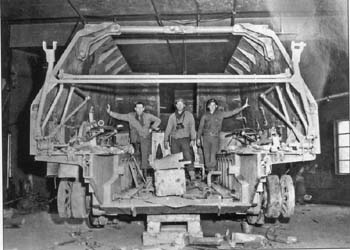 |
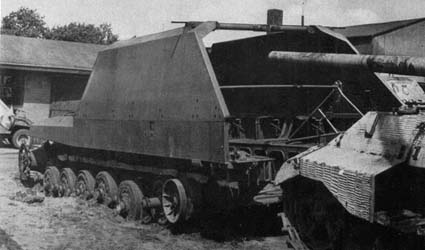 |
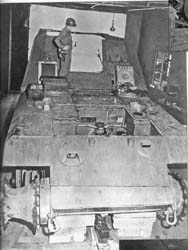 |
Waffenträger "Grille"
17 cm K72, 21 cm MRS 18/1 ünd 30.5cm GRW (Sf)
|
||
src: Site Planet
Armor
|
||
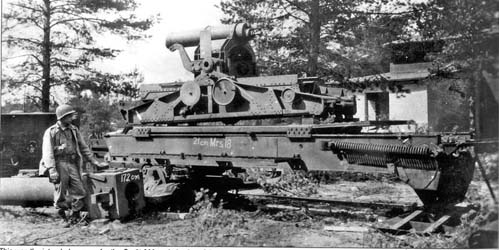 |
The mount for 17 cm K72 & 21 cm MRS 18/1
ünd (?) 30.5cm GRW (Sf)
|
src: Site Planet
Armor
|
Drawings |
30.5cm Gr.W 16(Sf.) or 42cm Gr.W 12.2(Sf.) / Geschützwagen VI (Grille 30/40)
Projets parallèles aux Grille 17/21 auf Geschützwagen VI Tiger, initié par le Wuffenamt Prüfwesen 4 (Wu Prüf 4) Abteilung Artillerie, de deux canons automoteurs lourds, armés pour l'un d'un schwerer Granatwerfer de 305 mm et pour l'autre d'un schwerer Granatwerfer de 420 mm. Deux armes dont le développement ne débutera qu'à la fin de la guerre et ne seront jamais opérationnelles. En janvier 1945 la firme Skoda à Pilsen (Tchécoslovaquie) travaille sur la commande d'un schwerer Granatwerfer L/16 de 305 mm. L'étude grâce à la récupération d'éléments pré-existants, ne dure que 20 jours et un prototype (Skoda B-20) est très vite complété. Il sera trouvé par l'armée américaine sur le site de Pilsen. La pièce d'artillerie d'un poids de 17,8t, aurait supposé un poids total avec le porteur d'arme chenillé (Waffenträger) de 57,8t, voir 65t selon les sources ! Cette arme pouvait propulser un obus de 160 kg à 10000 m avec une vitesse initiale de 430 m/s, avec un pointage en élévation maximale de +75°. Cet arme bien que possédant une faible vélocité initiale, était avant tout destinée à effectuer des tirs indirects en courbes. L'ensemble complet est parfois référencés comme 30.5cm Mörser auf Panzer VI Ausf.B Fahrgestell ou encore en tant que Grille 30.
Parallel projects with Grille 17/21 Auf Geschützwagen VI Tiger, initiated by the WUFFENAMT PRÜFWESEN 4 (Wu Prüf 4) Abteilung Artillery, of two heavy self-propelled guns, armed for one of a schwerer Granatwerfer of 305 mm and for the other from a schwerer Granatwerfer of 420 mm. Two weapons whose development will only begin at the end of the war and will never be operational. In January 1945 Skoda firm in Pilsen (Czechoslovakia) works on the order of a 305 mm Schwerer Granatwerfer L/16. The study thanks to the use of pre-existing elements, lasts only 20 days and a prototype (Skoda B-20) is very quickly completed. It will be found by the American army on the Pilsen worksite. The artillery piece with a weight of 17.8t, would have with its weapon carrier (WaffenTräger) a supposed total weight of 57.8t, see 65t depending on the source! This weapon could propel a round of 160 kg to 10000 m with a muzzle velocity of 430 m/s, with a maximum elevation of + 75°. This weapon although possessing a low muzzle velocity, was primarily intended to perform indirect curve shots. The complete set is sometimes referenced as 30.5cm Mörser auf Panzer VI Ausf.B Fahrgestell or as Grille 30.
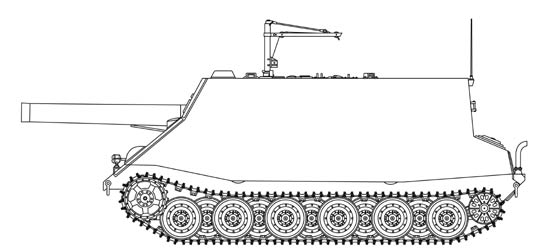 |
30.5cm Gr.W 16 (Sf.)/Geschützwagen VI
|
La firme Skoda travaille aussi en janvier 1945 sur la commande d'un schwerer Granatwerfer L/12.2 de 420 mm. L'étude sera cependant stoppée par la défaite allemande. Cependant un démonstrateur sera bien complété par les Alliés en 1946, sans entrer en production. Cette arme devait pouvoir propulser un obus de 400 kg à 10000 m avec une vitesse initiale de 385 m/s, avec un pointage en élévation maximale de +75°. Comme pour le modèle de 305 mmn cette pièce d'artillerie lourde, était avant tout destinée à effectuer des tirs indirects en courbes. L'ensemble complet estimé à plus de 65t est parfois référencés comme 42cm Mörser auf Panzer VI Ausf.B Fahrgestell ou encore en tant que Grille 40.
The Skoda firm also works in January 1945 on the order of a Schwerer Granatwerfer L/12.2 of 420 mm. The study will however be stopped by the German defeat. However, a demonstrator will be completed by the Allies in 1946, without going into production. This weapon was to be able to propel a round of 400 kg to 10000 m with an initial speed of 385 m/s, with a maximum elevation of + 75°. As with the 305 mmn model this heavy artillery piece, was primarily intended to perform indirect curve shots. The complete set estimated at more than 65t is sometimes referenced as 42cm Mörser Auf Panzer VI Ausf.B Fahrgtesell or as Grille 40.
Ces projets ne virent jamais le jour, la priorité étant donné à la production de chars standard. De toute façon la plate-forme du Pz.kpfw VI Ausf.B Tiger II était destinée à être remplacés par celles prévues pour les projets des Entwicklungstypen (Série E) prévus pour 1946. L'Oberkommando des Heeres finira par annuler en 1945 ces projets d'automoteurs lourds qui collectionnaient les problèmes techniques rendant impossible une production en série dans un avenir proche.
These projects never saw the day, the priority given to the production of standard tanks. Anyway the Pz.Kpfw VI Ausf.B Tiger II platform was intended to be replaced by those planned for the Entwicklungstyphen (E-Serie) projects for 1946. The Oberkommando des Heeres will eventually cancel these projects in 1945 of Heavy self-propelled guns that collected the technical problems making it impossible mass production in the near future.
Drawings |
Sources:
- Connaissance de l'Histoire (Hachette) - N°17 - " Les chars de combat allemands 39-45"
- Connaissance de l'Histoire (Hachette) - N°5 - " Véhicules blindés allemands 39-45"
- Les Blindés de la Seconde Guerre Mondiale (Atlas)
- Sturmartillerie & Panzerjäger 1939-1945 (Osprey Military) - New Vanguard N°34
- Site "Achtung Panzer" - http://www.achtungpanzer.com
- Site "WWII Vehicles" - http://www.wwiivehicles.com
- Site "Second World War Armour" - http://www.onwar.com/tanks/index.htm

/USA/Models/Dioramas/Ohe-Partisans/Bt-off.jpg)

